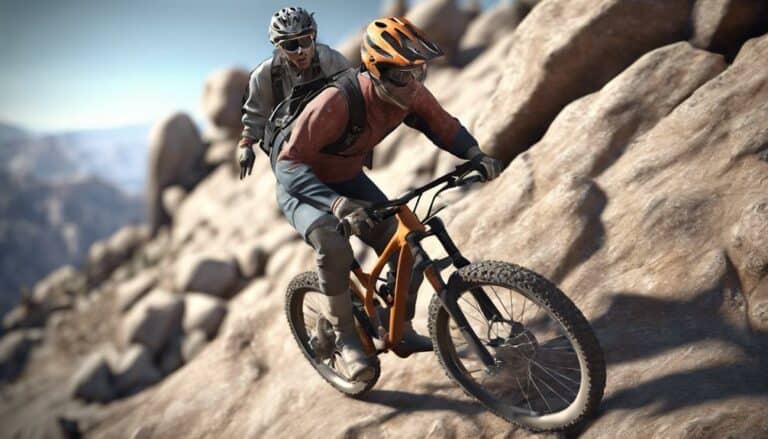When tackling rocky terrain on your off-road adventure, the way you position your body can be a game-changer.
Each type of off-road terrain demands a unique approach to body positioning that can make all the difference between a smooth ride and a bumpy one.
The way you adjust your body on sand dunes versus mud tracks or steep inclines versus tight trails can greatly impact your control and stability on the bike.
Understanding these nuances can elevate your off-road riding skills and make your next adventure even more exhilarating.
Key Takeaways
- Standing position varies for rocky terrain and mud tracks to optimize control and maneuverability.
- Weight distribution changes on sand dunes and steep inclines for traction and stability.
- Engage core muscles on rocky terrain and steep inclines for stabilization and climbing support.
- Utilize footpegs differently on sand dunes and mud tracks to enhance balance and steering ability.
Body Positioning on Rocky Terrain
When riding on rocky terrain, maintain a standing position to absorb impacts and enhance control over the bike. By staying on your feet, you can better maintain balance and maneuver through various obstacles with greater ease.
Keep your knees bent and flexible, allowing your body to adjust to the uneven surfaces while keeping your center of gravity low for stability. Shift your weight slightly backward to prevent the front wheel from getting stuck on rocks, improving traction on the rear wheel.
Engage your upper body by using your arms and core muscles to stabilize the bike, ensuring precise navigation through rocky sections. Focus your eyes on the path ahead to anticipate obstacles and choose the best line to conquer the challenging terrain.
Proper body positioning on rocky terrain is key to a liberating off-road experience, empowering you to conquer obstacles with confidence and finesse.
Body Positioning on Sand Dunes
Shifting your focus to tackling sand dunes demands a slight lean back to prevent the front wheel from sinking in as you navigate the sandy terrain. To maintain control and balance on this challenging surface, remember to keep your body weight centered and adopt a straight body position.
Here are three essential tips for mastering body positioning on sand dunes:
- Maintain a Straight Body Position: By keeping your body upright and centered over the bike, you can improve stability and control as you traverse the sandy terrain. Avoid leaning too far forward, as this can cause the front wheel to bury itself in the sand.
- Balance Your Body Weight: Distribute your weight evenly between the footpegs to prevent the bike from tipping over on the shifting sand. This balanced stance will help you navigate the dunes with confidence and agility.
- Keep Your Feet on the Footpegs: Use a wider stance with your feet on the footpegs to enhance your balance and traction on sandy surfaces. This position allows you to react quickly to the changing terrain and maintain control of the bike.
Body Positioning on Mud Tracks
Traversing muddy tracks requires you to stand up on the footpegs, utilizing a wide stance and keeping your knees bent to absorb the bumps and ruts of the slippery terrain. By leaning your body slightly back, you prevent the front wheel from digging into the mud, maintaining control and balance.
Use your core muscles and legs to steer the motorcycle through the challenging mud tracks, avoiding overreliance on the handlebars. Remember, body positioning in mud tracks demands constant adjustment to adapt to the changing grip levels and terrain conditions.
Stay agile and flexible, allowing your body to respond to the unpredictable nature of the muddy terrain. Embrace the freedom that comes with mastering your body position on mud tracks, feeling the thrill of conquering the challenging conditions with finesse and skill.
Body Positioning on Steep Inclines
Mastering body positioning on steep inclines requires you to lean forward to maintain traction over the front wheels and engage core muscles for stability while climbing challenging terrain. When tackling steep inclines, remember these key points to navigate the terrain effectively:
- Positioning Your Body:
Lean your body forward to distribute weight over the front wheels, ensuring ideal traction and control on the incline.
- Maintain Control:
Keep your core muscles engaged to stabilize your body and ATV while climbing steep slopes, preventing unnecessary tipping.
- Shift Your Weight Quickly:
As you encounter changes in terrain elevation, be prepared to shift your body weight uphill promptly to adapt to the varying angles and maintain stability.
Body Positioning on Tight Trails
When riding on tight trails, maintaining a centered body position with elbows out is crucial for better control and balance. To tackle sharp corners and obstacles, keep your elbows bent, allowing you to shift your weight more swiftly in the direction of the turn. Leaning the bike and pressing on the outside footpeg will help you navigate these narrow paths efficiently.
Remember to keep your elbows out to avoid losing your balance and to enable quick adjustments. Additionally, make sure your toes are pointing straight ahead to maintain stability and control. By staying straight and centered on the bike, you enhance your ability to maneuver through tight trails with ease.
Focus on looking ahead and anticipating changes in direction to smoothly navigate the twists and turns that characterize these challenging terrains. Adjusting your body positioning to lean with the bike as you turn will improve your traction and overall stability, making your ride both exhilarating and controlled.
Conclusion
You've now learned how to dance with your bike across rocky terrain, glide through sand dunes like a surfer, slay through mud tracks like a ninja, conquer steep inclines like a mountaineer, and navigate tight trails like a tightrope walker.
With the right body positioning, you can master any off-road terrain with grace and skill, turning your ride into a thrilling adventure full of twists and turns.
So go out there and ride like the off-road maestro that you are!

